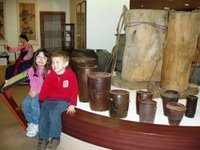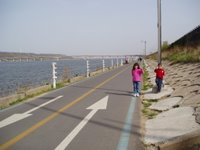Kimchi, Magpies & Wally World?
13 Apr 06
We've continued our cacheboxing tour of the Land of the Morning Calm. Today, we followed the GC road to COEX--Korea's World Trade Center complex in Central/East Seoul (Gangnam-gu district) only a couple kilometers away from the Olympic Stadium. We quickly found our 5th international cachebox and captured excellent impressions of a Singaporian 1 cent and 10 cent coin in our logbook. This particular GC was a typical 'limpet' style of 'hide-a-key' container that they painted gunmetal grey--common for urban environments. It was odd while stamping in because we felt a tad as if we were in Egypt. We were in the shadow of several pyramids in the area. Perfect timing because we're still studying Egyptian history in rnrB's studies.
We also came across this interesting sculpture of a girl playing a harp and some mythological creature floating in a cloud.
Just because we were in the area we decided to mall walk--not because we wanted to shop but rather because we were in search of KIMCHI. Granted the last intentional time we've stepped foot in a mall was during the 2004 DC/VA/MD Winter Icebreaker Gathering in Pentagon City, VA to attend a letterboxing gathering (& that didn't involve any shopping)--so mall walking after over a 2-year absence was definitely a shock to the system!!! I was curious to see what 'chain stores' would appear in a Korean mall. The only things we recognized through the hoards of people were a handful of the food and coffee shops and a single 7-11 store--as for clothing shops, didn't recognize a single one. Nor would I venture to guess that I'd fit in a single outfit in the entire mall (or all of Korea for that matter)--the sizes run really, really small!!! We did wander around the Hyundai Dept store and were amazed at their food kiosk selection--incredible!!! Korean food (duh), Indian (the na an looked & smelled awesome), Thai (yum--but we're heading there soon so we decided to wait), French pastry shops, Italian, Mexican, American, Chinese dim sum, rotating Japanese sushi bar, smoothie bars everywhere you looked, bubble tea venues, French bakery--the list is endless. How could one decide? We opted for Korean food, yet again, figuring when in Rome... ;)
...
...
You are about to learn more about Kimchi than you've ever wanted to know!!!
We visited the Kimchi Field Museum--a multi-faceted complex that is completely, utterly & totally dedicated to Kimchi! Who knew? This ain't your Grandma's kimchi, either.
...
Your tour is about to begin:
Over the years I've tasted many types of kimchi but I was always under the impression that kimchi was really just the stinky red pepper cabbage concoction that sort of smells like rotten (insert your favorite stinky material here). I always figured it had formaldehyde in it--but it probably doesn't now that I'm 'learned up' on the stuff. What I learned today was that kimchi is really a technique to preserve vegetables through fermentation and that many of the 'dim sum appetizer' dishes that one is served at Korean restaurants are technically kimchi. Kimchi can actually contain many different types of ingredients.
...
Kimchi is prepared by either:
salting vegetables,
dipping vegetables in paste, or
marinating vegetables.
...
If your goal is to preserve a vegetable for future use then you're creating a kimchi!
...
The history of kimchi goes back to circa 1168-1241 when it was first published in a "Book About Turnip Kimchi" by Yi Kyu Bo (yes, I figure you're yawning already!) but think about it--that's an awfully long time ago! This book contains a verse about 6 vegetables: cucumber, eggplant, turnip, green onion, mallow & white gourd and mentions that "the leaves of white radish dipped in paste are very good to eat during 3 months in summertime and the salted ones are endurable in wintertime." So the entire history of kimchi is predicated upon this short excerpt from an 800-year old book!!!
...
What I found interesting was that the hot red chili peppers (for which Korea is quite famous) weren't even introduced to Korea until much later. These red peppers that are THE ingredients of the famous Korean red pepper paste actual hail from Mexico and were brought to Korea via America through traders (possibly French or Japanese).
...
Much later on additional vegetables were incorporated into kimchi recipes including wild leeks, oriental parsley, Indian mustard leaf and bamboo shoots. So those types of kimchi are mere youngins (although they've probably been around some 600 years now) compared to the earliest ingredients.
...
Kimchi often incorporates the 5 main colors & 5 tastes for which Korea is famous:
COLORS:
blue, red, yellow, black & white
These colors represent space, direction, seasonal changes and the universe and are visible in Korea's flag (Pal Kwai) and traditional dress. The ingredients that represent these colors are: Korean cabbage, white radish, bluish green onion, yellowish garlic, ginger, blackish salted fish & red hot peppers.
...
TASTES:
hot, sweet, sour, salty & bitter
Once the ingredients are prepared they are placed in a kimchi pot--the traditional brown/burnt rust colored pottery with a flat top. There are different shapes of pots (again--who knew???) that are based on regional environmental differences.
In the North--the pots are very tall, with a sharp bulge and a large mouth. In the South--the pots are more slender with small mouths. The sun is scarce in the North and by incorporating a larger surface area on the lid and body, the pots absorb more of the sun's radiation and the larger mouth allows more moisture to disperse via evaporation. In the South, the more abundant sunlight causes too much evaporation so by incorporating a smaller 'exposed' area and a much smaller lid more moisture is retained in the container--to encourage the fermentation process.
Once the mixture is placed in the container it's either stored in the earth (for long-term storage) using a kimchi hut (as viewed here) or in pots on a kimchi terrace (for short-term storage) still quite common in Korean households today.
...
Kimchi is very healthful because it is rich in vitamins & minerals (specifically A, C, calcium, phosporous and iron).
...
Finally--I'm sure you're just dying for this to end by now--my favorite kimchi is the cucumber kimchi (oi sobagi), sesame leaf kimchi (khenip kimchi), persimmon kimchi (gam kimchi) or the eggplant kimchi (kaji kimchi). Yum! I still can't quite consume more than a couple bites of the standard cabbage kimchi, though--but I do have a much greater appreciation of it now. ;)
...
Hey, did I tell you they even make kimchi chocolate? I've purchased it but I have yet to taste it. Now that I've learned more than I've ever wanted to know about kimchi I may actually taste it someday soon. ;)
...
...
From the Kimchi Field Museum, we aimed our sights on more exercise. By bizarre happenstance, I had noticed Wally World (yes, Wally World!) on one of my tourist maps. I just had to check it out to see what it was like outside of the contiguous US. So, we walked about 4 kilometers out of our way to actually find it!!!
We also found this cool skyscraper...
but eventually we found the jewel in the rough!!!
WALLY WORLD!!!
(Wahl-Mah-tah-Syu-puh-saen-tuh)
And they even had an entire Lock N Lock section!!!
What was interesting is that in the US we usually only find products for sale at Wally World that are made in China but in an interesting twist of fate--here in the Korean Wally World, many of the products were actually made in the US! Now, that was rather interesting...
...
...
14 Apr 06
...
Our cacheboxing tour of Seoul continues. Yet, now our 'needle in the haystack approach' to finding geocaches in Korea without a GPS is getting more difficult. We've found many of the 'easy to nab if you've done your clue research' and have a great map in hand geocaches already. Now, we're branching out and taking major 'leaps of faith' in our needle in the haystack hunts. Today, this approach took us on about a 12 km hike for our beloved cachebox.
We opted to hunt out the Han River GC in Northwest Seoul. It initially took us on a couple of subway rides that involved about 20 some subway stops (not sure how far away that is as the magpie flies). We hopped off at Balsan Station and decided to walk the 2+km from the station to the bike trail along the Han River. That was where our haystack hunt would begin. So, once there we headed East. Uh oh...we should have headed West. So, 2km later, we decide to face about and head West.
We pass by 2 bridges and one bridge in progress and eventually find ourselves in a bird viewing area along the river. Good sign! Our clue is nothing but a grainy picture of a boardwalk with reeds about it. We soon find some boardwalk and follow it the entire length of about a 1-mile course and never find our prize.
**where the geocache wasn't!!!**
We actually found these cool wooden bird sculpture stakes all around the area, though.
**here's a view of the Han River through a unique bird-blind and a veil of reeds**
...
...
Then, we stumble on a map of the area and notice that there's yet another nature viewing area another 500 m West--so we press our luck and head there. We soon find the sought out boardwalk trail and lo & behold find our prize!!! Woo Hoo! As we visit our cachebox we opt to take our impression of a brass Egyptian 'Ankh' type figure and it works out well. International cachebox find #6! We have 300% more intl cachebox finds now than US cacheboxes. Woo hoo! Interesting how we experience yet another interaction with something from Egypt, too! We complete our outing and after some rough calculations realize we've invested about 12km of walking into finding this cache once we stepped foot off the subway at Balsan Station. BUT the coolest thing is that along the way we spy these awesome Magpies, a Great Blue Heron diving into the Han River, Egrets, diving Cormorants, flying fish, barge and tugboat traffic, helicopters flying about--you name it. It was definitely a cool experience!
Fresh from cacheboxing victory, rnrB & trkr decide to take the 'easy' way back to the subway station by walking along the levee adjacent the bike trail. Remember, this is the final 4km of a 12km outing from our destination subway stop! They're insane!
...
...
We spend about 45 minutes on the subway on our return trip--and realize that we've been travelling almost incessantly on the subway or wandering Seoul's streets or hiking trails for the past two weeks and are really finding it odd that we haven't seen as many Westerners out and about as we have in the past. In fact, during our entire 7-hour outing today we saw only 3 other Westerners besides us in the subway stations, on the train or along the Han River trail. How odd? No wonder the kids are garnering so much attention from folks on our outings as they have--their presence is unusual, I presume. Today, they received two packets of Chinese Aster flower seeds & chewing gum just sitting on the subway!
...
Our outings the past couple of days have taken us to some really unique and different places around town. We've seen some of the most 'urban' things you can see in Seoul and some of the most natural images--especially along the Han River. In a city that boasts a population of some 14 million it's difficult to find any place where you can just be 'alone'. The Han River trail that we found today has been about the closest place to finding this 'solitude' that we've found in the area.
...
Koreans consider Magpies that cross your path as 'lucky'.
Today, we've seen hundreds and hundreds of Magpies--to include this little fellow hanging out in the grass. Not sure if they've been lucky for us but we certainly enjoyed some incredible experiences today so we presume the adage is true. ;)
















0 Comments:
Post a Comment
<< Home